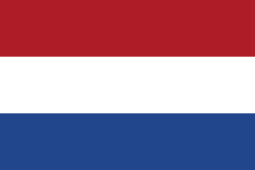Dutch flag
 |
|
| Name | Flag of the Kingdom of the Netherlands |
|---|---|
| Use | National flag and ensign |
| Proportion | 2:3 |
| Adopted | Officially adopted on 19 February 1937 |
| Design | A horizontal triband of red (Bright Vermilion), white, and Cobalt blue. |

Variant flag of Netherlands
|
|
| Name | The "Prinsengeus", the naval jack of the Netherlands. |
| Use | Naval Jack |
| Proportion | 2:3 |

Variant flag of Netherlands
|
|
| Name | Royal Standard of the Netherlands |
| Proportion | 1:1 |
| Adopted | 27 August 1908. |
| Design | A square orange flag, divided in four quarters by a nassau-blue cross with the small coat of arms of the Kingdom, surmounted by a royal crown and surrounded by the insignia of the Grand Cross of the Order of Willem. Each quarter shows a bugle-horn which originates in arms of the Principality of Orange. |
The flag of the Netherlands (Dutch: Vlag van Nederland) is a horizontal tricolor of red, white, and blue. The tricolor flag is almost identical to that of Luxembourg, except that it is shorter and its blue stripe is a darker shade.
It originates as a variant of the older orange-white-blue Prinsenvlag ("Prince's Flag"), introduced in the 17th century as the Statenvlag ("States Flag"), the naval flag of the States-General of the Dutch Republic.
Its official status as the national flag of the Kingdom of the Netherlands was formalized in 1937.
The national flag of the Netherlands is a tricolor flag. The horizontal fesses are bands of equal size in the colors from top to bottom, red (officially described as a "bright vermilion"), white (silver), and blue ("cobalt blue"). The flag proportions (width:length) are 2:3. The first stadtholder of the Dutch Republic was William I of Orange, who joined with Dutch nationalists and led the struggle for independence from Spain. Partly out of respect for him, the first flag adopted by the Dutch was a horizontal tricolor of orange, white, and blue. It became known as the Prinsenvlag ("Prince's flag") and was based on the livery of William of Orange. The orange dye was particularly unstable and tended to turn red after a while, so in the mid-17th century, red was made the official color. The flag has flown since then, but was confirmed by Royal Decree only in 1937, at the same time the color parameters were exactly defined. As the first revolutionary flag, it has had a seminal influence throughout the world, particularly on the Pan-Slavic colors of Russia. Until about 1800, in the case of both the orange- and the red-striped versions, the number of stripes and their order frequently varied.
...
Wikipedia
